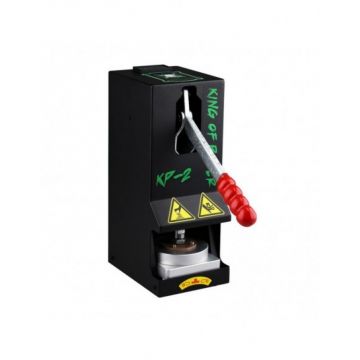Rosin press
Step into the fascinating world of the Rosin Press 🗜️, where art and science come together to reveal the purest essence of cannabis 🌿. Discover how heat 🔥 and pressure combine to create a concentrate that tantalizes the senses and elevates the cannabis experience to new heights 🚀. Let's explore together how this revolutionary machine is changing the cannabis community 🌐. Want to learn more? Read more at the bottom of the page!
Engaging blogs about Rosin press

Fijne service en snel
Really a top tier site everything seems a bit fake but they have the best prices and a really fast delivery with trackingorder. Goated website big probs
What Is Rosin?
Rosin is a solvent-free cannabis concentrate that has gained popularity in the cannabis community in recent years. It is known for its simple production process and the ability to deliver high-quality concentrates without the use of chemical solvents such as butane or propane. Let's delve deeper into what rosin is and why it has captured the attention of so many cannabis enthusiasts.
How Does Rosin Pressing Work?
Rosin pressing is a relatively simple process that yields high-quality cannabis concentrates without the use of solvents. In this chapter, we will delve into the steps and the mechanism behind the rosin pressing process.
The Pressing Process
The rosin pressing process begins with the selection of high-quality cannabis flowers or hash. This raw material is then placed between two heated plates, typically made of metal. The plates are firmly pressed together using a hydraulic or pneumatic press. The key elements of this process include:
1. Temperature
The temperature of the press plates is a crucial factor in the rosin pressing process. Typically, the temperature ranges between 150°C and 220°C (300°F and 430°F), depending on the desired consistency and the type of material being pressed. Lower temperatures preserve more terpenes and result in a more aromatic end product, while higher temperatures may yield more quantity.
2. Pressure
The pressure applied to the cannabis between the plates is another important parameter. Pressure causes the resinous trichomes in the plant to burst and release. The ideal pressure varies but usually falls between 500 and 2,000 psi (pounds per square inch). Too much pressure can lead to quality loss, while too little pressure may not provide adequate extraction.
3. Duration
The duration of the pressing process varies depending on the desired results, but most pressing cycles last between 30 seconds and several minutes. A shorter time may result in a more flavorful end product, while a longer duration may yield more quantity.
Mechanism of Extraction
The rosin pressing process is based on the principles of heat and pressure, which transform the resinous trichomes in cannabis into a viscous, sticky substance. During pressing, the trichomes burst open, releasing their contents, including cannabinoids like THC and CBD, as well as terpenes responsible for the taste and aroma of cannabis.
Materials Needed for Rosin Pressing
To get started with rosin pressing, you'll need certain materials to successfully carry out the process. We'll provide a list of essentials for rosin pressing, as well as optional items to enhance your pressing process.
Essential Supplies
1. Cannabis Raw Material
The foundation of rosin pressing is high-quality cannabis. You can choose between cannabis flowers or hash, depending on your preference and availability. Ensure that the raw material is fresh and of high quality for the best results.
2. Press Plates
A rosin press has two heated plates between which the cannabis is placed. These plates should be made of high-quality material, typically stainless steel, and they should be of the right size to exert sufficient pressure.
3. Press
A press machine is crucial for applying the required pressure to the cannabis between the plates. There are various types of presses available, including manual presses and hydraulic presses. The choice depends on your budget and the amount of rosin you want to produce.
4. Heat Source
To heat the press plates, you'll need a heat source. This can be an electric heater built into the press machine or an external heat source, such as a heat press.
5. Temperature and Pressure Controller
For precision during the pressing process, it's helpful to have a temperature and pressure controller. This allows you to set the right temperature and pressure for the desired results.
Optional Equipment
1. Pollen Press
A pollen press is useful for collecting and shaping rosin after pressing into easily manageable portions. It provides a professional appearance to your end product.
2. Microscope
A microscope can be used to inspect the quality of your rosin, including the presence of any impurities. This is especially important if you aim for the highest quality.
3. Quality Control Equipment
Some growers and producers invest in laboratory equipment to test the quality of their rosin, including cannabinoid and terpene concentration. This is important for consistent production.
Steps for Rosin Pressing
Now that we have prepared our equipment and supplies, it's time to embark on the exciting journey through the art of rosin pressing! ? From preparing your raw material to harvesting the precious rosin, we will guide you step by step through this captivating process. It's time to unveil the magic of rosin extraction. Let's get started!
Step 1: Preparing the Cannabis
Before you begin pressing, you need to prepare your cannabis. Make sure the cannabis is fresh and high quality. If you are using cannabis flowers, you can grind or chop them to increase the surface area of the trichomes. If you are using hash, crumble it to a uniform texture if necessary.
Step 2: Heating the Press Plates
Turn on your press machine and heat the press plates to the desired temperature. The right temperature depends on the type of material you are pressing and your pressing preferences. Typically, the temperature ranges between 150°C and 220°C (300°F and 430°F).
Step 3: Placing the Cannabis Between the Plates
Place your prepared cannabis between two sheets of non-stick parchment paper or a special rosin press bag


